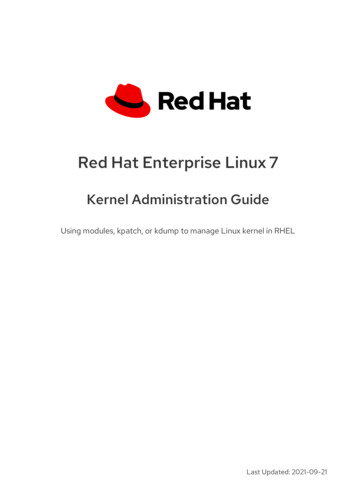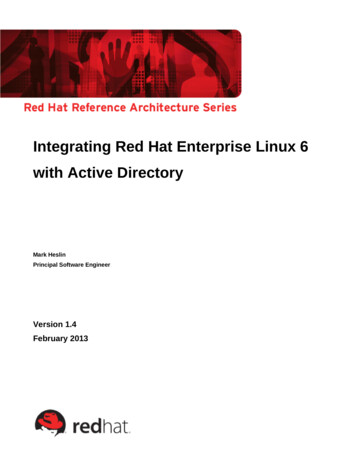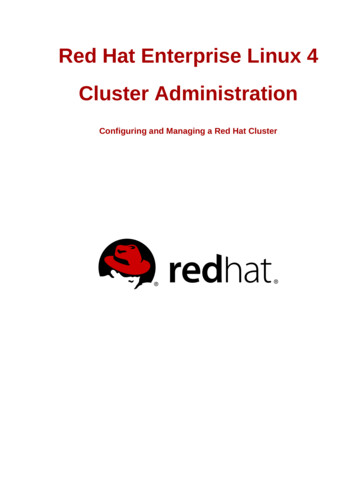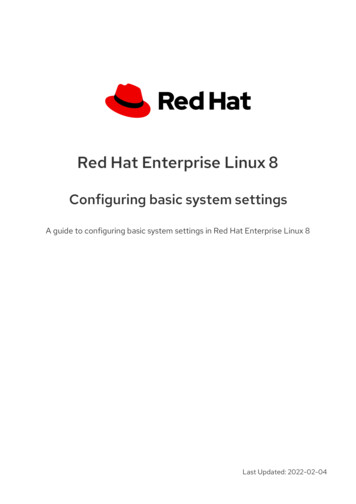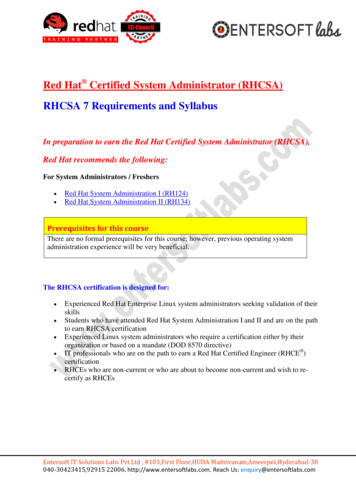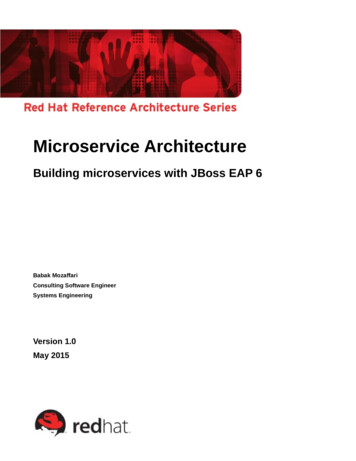
Transcription
Microservice ArchitectureBuilding microservices with JBoss EAP 6Babak MozaffariConsulting Software EngineerSystems EngineeringVersion 1.0May 2015
100 East Davie StreetRaleigh NC 27601 USAPhone: 1 919 754 3700Phone: 888 733 4281Fax: 1 919 754 3701PO Box 13588Research Triangle Park NC 27709 USALinux is a registered trademark of Linus Torvalds. Red Hat, Red Hat Enterprise Linux, the Shadowmanlogo, JBoss, MetaMatrix, Fedora, the Infinity Logo, and RHCE are trademarks of Red Hat, Inc.,registered in the United States and other countries.Apache, ServiceMix, Camel, CXF, and ActiveMQ are trademarks of Apache Software Foundation. Anyother names contained herein may be trademarks of their respective owners.All other trademarks referenced herein are the property of their respective owners. 2015 by Red Hat, Inc. This material may be distributed only subject to the terms and conditions setforth in the Open Publication License, V1.0 or later (the latest version is presently available athttp://www.opencontent.org/openpub/).The information contained herein is subject to change without notice. Red Hat, Inc. shall not be liablefor technical or editorial errors or omissions contained herein.Distribution of modified versions of this document is prohibited without the explicit permission of RedHat Inc.Distribution of this work or derivative of this work in any standard (paper) book form for commercialpurposes is prohibited unless prior permission is obtained from Red Hat Inc.The GPG fingerprint of the security@redhat.com key is:CA 20 86 86 2B D6 9D FC 65 F6 EC C4 21 91 80 CD DB 42 A6 0Ewww.redhat.comiirefarch-feedback@redhat.com
Comments and FeedbackIn the spirit of open source, we invite anyone to provide feedback and comments on any referencearchitectures. Although we review our papers internally, sometimes issues or typographical errors areencountered. Feedback allows us to not only improve the quality of the papers we produce, but allowsthe reader to provide their thoughts on potential improvements and topic expansion to the papers.Feedback on the papers can be provided by emailing refarch-feedback@redhat.com. Please refer tothe title within the email.Staying In TouchJoin us on some of the popular social media sites where we keep our audience informed on newreference architectures as well as offer related information on things we find interesting.Like us on Facebook:https://www.facebook.com/rhrefarchFollow us on Twitter:https://twitter.com/RedHatRefArchPlus us on Google arch-feedback@redhat.comIIIwww.redhat.com
Table of Contents1 Executive Summary. 12 Microservice Architecture. 22.1 Definition. 22.2 Tradeoffs. 32.2.1 Advantages. 32.2.2 Disadvantages. 32.3 Distributed Modularity Model. 42.3.1 Overview. 42.3.2 Monolithic Applications. 52.3.3 Tactical Microservices. 72.3.4 Strategic Microservices. 92.3.5 Business-Driven Microservices. 122.4 Cross-cutting concerns. 142.4.1 Overview. 142.4.2 Containerization. 142.4.3 Service Discovery. 142.4.4 Load Balancer. 152.4.5 Cache. 152.4.6 Throttling, Circuit Breaker, Composable Asynchronous Execution. 152.4.7 Security. 162.4.8 Monitoring and Management. 162.4.9 Resilience Testing. 162.5 Anatomy of a Microservice. 173 Reference Architecture Environment. 184 Creating the Environment. 194.1 Prerequisites. 194.2 Downloads. 194.3 Installation. 204.4 Configuration. 204.4.1 Apache httpd Server. 224.4.2 MySQL / MariaDB Database. 254.4.3 JBoss Enterprise Application Platform. 264.5 Deployment. 274.6 Execution. 28www.redhat.comivrefarch-feedback@redhat.com
5 Design and Development. 355.1 Overview. 355.2 Integrated Development Environment. 355.2.1 JBoss Developer Studio.5.2.2 Creating a Maven Project.5.2.3 Configuring Java 7.5.3 Java Persistence API (JPA).353638395.3.1 Overview.5.3.2 Persistence Unit.5.3.3 Persistence Entity.5.3.4 Database setup.5.4 RESTful API.39394144505.4.1 Enabling JAX-RS support. 505.4.2 RESTful Service. 525.4.3 Transactional Behavior. 545.4.4 Logging. 555.4.5 Error handling. 565.4.6 Resource API design. 625.4.7 Other RESTful operations. 695.4.8 Pessimistic Locking. 715.4.9 Sales service. 725.4.10 Sub-resources, RESTful relationships. 845.4.11 Billing Service. 915.5 Aggregation/Presentation Layer. 936 Conclusion. 127refarch-feedback@redhat.comvwww.redhat.com
1 Executive SummaryThe Information Technology landscape is constantly shifting and evolving. Advancement incomputer hardware has continually increased processing power and storage capacity, whilenetwork and internet connectivity has become faster and more widespread. Along with theproliferation of mobile devices, these factors have resulted in a global user-base for a largenumber of software services and applications.Software designers and developers are not isolated from these changes; they must accountfor the experiences of the past as well as the characteristics of this ever-changing landscapeto continually innovate in the way software is designed and delivered. The microservicesarchitectural style is one such effort, aiming to apply some of the best practices learned in thepast towards the requirements and the dynamically scalable deployment environments ofcertain software and services of the present and near-future.This reference architecture recites the basic tenets of a microservice architecture andanalyzes some of the advantages and disadvantages of this approach. This paper expresslydiscourages a one size fits all mentality, instead envisioning various levels of modularity forservices and deployment units.The sample application provided with this reference architecture demonstrates BusinessDriven Microservices. The design and development of this system is reviewed at length andthe steps to create the environment are com
2 Microservice Architecture2.1 DefinitionMicroservice Architecture (MSA) is a software architectural style that combines a mixture ofwell-established and modern patterns and technologies to achieve a number of desirablegoals.Some aspects, for example a divide and conquer strategy to decrease system complexity byincreasing modularity, are universally accepted and have long been cornerstones of othercompeting paradigms.Other choices carry trade-offs that have to be justified based on the system requirements aswell as the overall system design.General characteristics of microservices include: Applications are developed as a suite of small services, each running as anindependent process in its own logical machine1 (or Linux container) Services are built around capabilities2: single responsibility principle One can independently replace / upgrade / scale / deploy services Standard lightweight communication is used, often REST calls over HTTP Potentially heterogeneous environments are supported1 l#ComponentizationViaServices2 m2refarch-feedback@redhat.com
2.2 TradeoffsThe defining characteristic of a Microservice Architecture environment is that modularservices are deployed individually and each can be replaced independent of other services orother instances of the same service. Modularity and other best practices yield a number ofadvantages but the most unique tradeoffs from MSA are the result of this characteristic.2.2.1 Advantages Faster and simpler deployment and rollback with smaller services. Taking advantage ofthe divide and conquer paradigm in software delivery and maintenance. Ability to horizontally scale out individual services. Not sharing the same deploymentplatform with other services allows each service to be scaled out as needed. Selecting the right tool, language and technology per service, without having toconform to a homogeneous environment being dictated by shared infrastructure. Fault isolation at microservice level by shielding services from common infrastructurefailure due to the fault of one service. Where the failure of some microservices can betolerated by the system, this results in Higher Availability for the system. Well-suited for Continuous Delivery and Integration, given lower service granularity. Promotes DevOps culture with higher service self-containment and less commoninfrastructure maintenance. More autonomous teams lead to faster/better development. Traditional divide and conquer benefits2.2.2 DisadvantagesThe downsides of MSA are direct results of higher service distribution. There is also a highercost to having less common infrastructure. Disadvantage may be enumerated as follows: Less tooling / IDE support given the distributed nature. QA, particularly integration testing can be difficult. Debugging is always more difficult for distributed systems. Higher complexity – higher fixed cost and overhead. Heterogenous environments are difficult and costly to m
2.3 Distributed Modularity Model2.3.1 OverviewWhile modular design is a common best practice that is appropriate in just about allcircumstances and environments, the logical and physical distribution of the modular unitsgreatly vary, depending on the system architecture.Some factors to consider: The number of developers: The ideal size of a development team is between 5 and 10people and each team can focus on one or more microservices.3 In an organizationwith only 1 or 2 development teams, the case for decoupling the work is lesscompelling and the resulting overhead from the architectural choices may be too costly. Are you comfortable on the cutting edge of technology? In its specific shape and form,Microservice Architecture is a new paradigm with only a handful of success storiesbehind it. The tools and infrastructure to support MSA are neither abundant nor mature,and the cost of adoption is still high. Can you adapt your staffing to DevOps? One of the benefits of MSA is its amenabilityto a DevOps method and the resulting higher agility. This requires lines to be blurredbetween development and operations. Not every organization is prepared for therequired cultural change. How skilled are you at troubleshooting system errors? Like any distributed system, anMSA environment can be very difficult to analyze and troubleshoot. Can you afford higher up-front costs?4 Just about every software methodology andparadigm seeks to maximize the return on investment and minimize the costs.However, costs are not always evenly distributed in various stages of the softwarelifecycle. Individual service deployment and a distributed architecture increasescomplexity and the fixed cost associated with the environment. Do you have a network that can support the architecture? The distributed nature of anMSA environment puts more stress on the network and conversely, a more reliablenetwork is required to support such an architecture.3 l#HowBigIsAMicroservice4 eedback@redhat.com
2.3.2 Monolithic ApplicationsWhile many Microservices advocates may use the term monolithic disparagingly, this paperreserves judgement on this design and views it as the result of a series of legitimate tradeoffs. This style of architecture may be preferable for certain situations and not for others.Monolithic applications may be just as modular as microservices, but those modules aretypically bundled as a single EAR or WAR file and deployed on a single application server andtherefore the same logical machine. In this model, all the modules take advantage of thesame infrastructure and maximize efficiency by minimize network traffic and latency. In somesituations, it may even be possible to pass arguments by reference and avoid serializationand data transfer costs.This diagram shows a traditional Java EE application deployed on a logical machine. It isemphasized that this single application consists of two web applications as well as threebusiness services, each being modular (containing six embedded modules each):Figure 2.3.2-1: Java Enterprise ApplicationThis deployment model minimizes overhead by sharing the application server andenvironment resources between various com
Horizontal scaling of such an architecture is simple and often benefits from the clusteringcapabilities of the underlying application server. Most often, the entire environment isduplicated and the application server replicates any stateful application data that is held inmemory:Figure 2.3.2-2: Clustered Java EE ApplicationThe uniformity and consistency of the replicated environment can be as much a handicap, asit is an asset. Deployment, testing and maintenance is simplified and the consistency avoidsvarious technical and logistics issues.Things begin to change when one service is much less stable and requires more resourcesthan others. Imagine that the first of the three business services is ten times more likely tohang or otherwise display unpredictable behavior. If that service can crash and bring downthe server, it would also take down the other two services. Scaling out this service wouldlikewise require scaling out the entire environment including services that may not have asmuch load or resource requirements. These issues are some of the biggest drivers of themicroservice t.com
2.3.3 Tactical MicroservicesOne possible strategy is to address the weaknesses of a traditional monolithic applicationarchitecture while continuing to take advantage of its benefits. Instead of proactivelydecomposing the application into microservices to potentially isolate them or separately scaleeach out, one may prefer to take advantage of the common infrastructure and environmentuniformity where possible, while explicitly identifying and extracting components that warrantisolation or individual scaling. For example, if one of the business services in the applicationdepicted in Figure 2.3.2-1: Java Enterprise Application is unstable or requires moreresources, or if it is best maintained as a small and separate unit that is managed by adedicated team, it may be deployed separately. Similarly, a component within anotherbusiness service may be extracted and separated:Figure 2.3.3-1: Tactical MicroservicesNotice that in this architecture, each new deployment is self-encapsulated and includes itsown persistence. The business service continues to be called from the web application,although new restrictions are imposed and this call is now necessarily a remote call. It ispreferable to follow RESTful practices and communicate using XML or JSON, over HTTP or asimilar om
This architecture allows the business service and the newly independent microservice to bescaled out separately:Figure 2.3.3-2: Tactical Microservices, HAIn the simple (and unrealistic) scenario that the remainder of the application requires a singleinstance while the business service needs two and the new microservice has three instances,the application directs its calls to load balancer, which in turn distribute the load betweenavailable services and provide the necessary failover.The new services are isolated and the rest of the application is at least partially protectedfrom their failure. These services may be scaled out dynamically as required without theoverhead of replicating the entire .com
2.3.4 Strategic MicroservicesThe architecture previously described in Tactical Microservices is either reactively separatingout microservices that require complete isolation or have separate scaling needs, oranticipating such scenarios and proactively deploying them as individual microservices.The Microservice Architecture paradigm can be fully embraced by decomposing entireapplications into microservices and implementing entire systems as separately deployedmicroservices regardless of actual or anticipated isolation needs of individual services:Figure 2.3.4-1: Strategic MicroservicesIn this architecture, each microservice includes its own persistence, which is at least logicallyencapsulated within the service. Each such service can be independently deployed, scaled,upgraded and replaced. The environment is fundamentally heterogeneous, so whileframeworks and infrastructure services may be available to provide features and functions,each microservice is free to use its preferred technology. Some of these microservices maybe running on a Java EE Server but overhead costs can be exorbitant and should be takeninto at.com
In this architecture, each microservice is easy to deploy, roll back and upgrade. Separateteams can work on separate microservices and the divide and conquer philosophy is used infull force. While the diagram depicts a single web application, there may in fact be zero, one,or many web applications invoking these microservices. Microservices may also depend on adata service layer for persistence, or may in fact not have any persistence requirements.It is assumed that every microservice has multiple instances deployed but the number ofinstances depends on the load and mission criticality of the service in question. It is no longernecessary to deploy 10 copies of one service, because a different service needs 10 activecopies to serve its purpose:Figure 2.3.4-2: Strategic Microservices, HAwww.redhat.com10refarch-feedback@redhat.com
Notice that in this architecture diagram, some microservices are depicted as having fewerinstances than others. Another obvious benefit of this approach is that the failure of a hostdue to a misbehaving service can be tolerated with minimal impact on other services.As shown in the diagram, each microservice has its own persistence store. This is of course alogical data store to avoid creating dependency or coupling between the microservices. Thissame objective can be achieved by abstracting away the data store with a data service layer.This reference application makes a compromise in using a single database server, accesseddirectly by the microservices, while using separate schemas to segregate the services.However, with a large number of microservices, each service may depend on a number ofother services, each of which is deployed and scaled out in unknown locations. This leads tothe requirement for a comprehensive service discovery solution, where services areregistered as soon as they come up on a node and deregistered when they are taken offline.To avoid a single point of failure, such a service discovery solution would have to bereplicated and highly available. Despite its HA nature, most services would also need tocache the results and be prepared to work when unable to access this solution.Load balancing can quickly get more complex when a large number of microservices arescaled out in different numbers and the dependency graph gets more depth and breadth.Services might require their own distinct load balancing strategy and an extra hop in such anenvironment may prove costlier than usual.The performance cost of making repeated remote calls typically leads to extensive cachingrequirements. The most often requirement is to have a service cache so that repeated andoften expensive calls to the same microservice may be avoided.High granularity along with a distributed deployment can also lead to orchestrationchallenges. Because of network latency, parallel invocation of services often becomesdesirable, leading to the need for a queuing, asynchronous invocation and orchestration ofrequests and responses.In general, as the environment becomes more heterogeneous, using uniform tooling andinfrastructure becomes a less viable option.refarch-feedback@redhat.com11www.redhat.com
2.3.5 Business-Driven MicroservicesIt must be emphasized that a microservice architectural style carries a lot of real benefitsalong with very real costs. The complexity of the system can grow exponentially with a largenumber of distributed components, each separately scaled out and perhaps dynamically autoscaled.Like most decisions, this does not have be a binary choice. The modularity of the servicescan determine the complexity of the environment as well as the benefits and costs that arerealized.A distributed business-driven microservice architecture can achieve many of the benefits,while avoiding some of the costs:Figure 2.3.5-1: Business-Driven MicroservicesAn important and distinguishing characteristic of this architecture is that microservices do notcommunicate with one another. Instead, an aggregation layer is provided in the form of a webapplication that provides the required at.com
The three services in this architecture diagram exist within a trust perimeter and the webapplication is the only client permitted to directly access these services. To use a differentpresentation technology, the web layer may be replaced with an aggregation layer thatexposes a REST or other API. For example, JavaScript and similar technology may replacethe Servlet layer and instead make direct calls to the server. In such a setup, the aggregationlayer would be the only service exposed to outside clients and it would carefully design andexpose an API where each operation would orchestrate and coordinate the underlyingservices as needed.The architecture presented in this diagram avoids certain costs and continues to benefit fromsupported and familiar products and frameworks by constraining modularity and avoidingcomplex dependency graphs.In its simplest form, microservices in this architecture remain self-contained within the systemby avoiding any dependencies on other microservices. This does not include externaldependencies, but is an attempt to simplify the environment by avoiding a large and deepdependency graph within the system.When a certain component requires special consideration, either in its scaling requirements orin terms of fault isolation, it can be broken out and deployed independently. This can lead to ahybrid solution incorporating some of the tactical considerations of the previously describedarchitecture depicted in Figure 2.3.3-1: Tactical Microservices.System requirements, willingness to be an early-adopter, in-house skill set, required agilityand other factors can determine the best fit for an environment. There are systems andenvironments, for which a monolithic application architecture is the best fit. There are alsovery agile software groups creating fast-evolving systems that receive a large return oninvestment in strategic microservices. For a large group in-between, this approach can be asafe and rewarding compromise to gain many of the benefits without paying all of the costs.Application server clustering can be used in this model to provide high availability. Whenemploying horizontal scaling to provide redundancy and load balancing, service modularitydetermines the pieces that can be scaled out separately.In Figure 2.3.5-1: Business-Driven Microservices, Service 1 may be part of a 3-node clusterwhile Service 2 is clustered as 10 nodes and Service 3 only has a single active backup.Likewise, a catastrophic failure as a result of Service 1 would have no impact on Service 2and Service 3, as they are separately packaged and om
2.4 Cross-cutting concerns2.4.1 OverviewAny system has a series of cross-cutting concerns, preferably addressed through consistentand common solutions that result in easier maintenance and lower cost. There are maturetools, frameworks and services that address such concerns and continue to be useful invarious architectural styles.The distributed and modular nature of microservice architecture creates new priorities andraises specific concerns that are not always adequately satisfied by traditional and availablesolutions.The nature and specifics of th
Building microservices with JBoss EAP 6 Babak Mozaffari Consulting Software Engineer Systems Engineering Version 1.0 May 2015. 100 East Davie Street Raleigh NC 27601 USA Phone: 1 919 754 3700 Phone: 888 733 4281 Fax: 1 919 754 3701 PO Box 13588 Research Triangle Park NC 27709 USA


